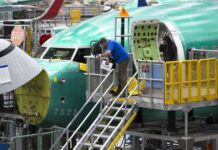General Motors (GM) has recently announced layoffs of over 1,000 salaried employees worldwide in its software and services division as part of a strategic review to streamline operations. This move comes as GM looks to create 4,000 new jobs while retaining 1,000, and significantly increasing battery cell and electric truck manufacturing capacity. The layoffs, which include around 600 jobs at GM’s tech campus near Detroit, follow recent leadership changes in the company’s software and services operations, including the departure of former Apple executive Mike Abbott in March.
A GM spokesman stated, “As we build GM’s future, we must simplify for speed and excellence, make bold choices, and prioritize the investments that will have the greatest impact.” The company expressed gratitude to those who helped establish a strong foundation that positions GM for future leadership. While GM declined to disclose the exact number of layoffs, a source familiar with the matter confirmed that more than 1,000 salaried employees would be affected, including 600 in Warren, Michigan. Impacted employees were notified on Monday morning.
The layoffs represent about 1.3% of GM’s global salaried workforce of 76,000 as of the end of last year, including approximately 53,000 U.S. salaried employees. This restructuring comes amid industry-wide efforts to reduce costs and employee headcount, particularly as automakers focus on investing billions in emerging markets such as all-electric vehicles and software-defined vehicles.
Focus on Software and Services
Software has become a significant focus for automakers like GM as they seek to monetize it and explore recurring revenue opportunities such as subscriptions to enhance profitability. GM’s software and services division encompasses various areas, including infotainment, the OnStar brand, and emerging technologies related to subscriptions and vehicle features. Two GM executives, Baris Cetinok and Dave Richardson, have taken over leadership roles following Abbott’s departure, overseeing software product management, program management, design, and engineering.
Cetinok, a seasoned software executive, serves as senior vice president of software and services product management, program management, and design. He is responsible for shaping GM’s software roadmap and overseeing the development, launch, and enhancement of software programs. Richardson, as GM’s senior vice president of software and services engineering, leads software engineering efforts in embedded platforms, digital products, commercial solutions, and advanced driver-assistance systems such as GM’s Super Cruise technology.
Industry Trends and Challenges
The automotive industry is undergoing a significant transformation, with a shift towards electric vehicles and software-defined vehicles. Automakers are investing heavily in these areas to stay competitive and meet evolving consumer demands. GM’s decision to streamline its software and services division reflects a broader trend within the industry to optimize operations, reduce costs, and focus on innovation.
The layoffs at GM highlight the challenges faced by traditional automakers as they navigate the transition to a more digital and electrified future. While these changes may lead to short-term disruptions for employees, they are essential for GM to remain agile, efficient, and competitive in the rapidly changing automotive landscape. By restructuring its software and services division, GM is positioning itself to lead in the development of next-generation vehicles and technologies.
Future Outlook and Opportunities
Despite the layoffs in its software and services division, GM remains committed to creating new job opportunities and expanding its manufacturing capacity for electric vehicles and battery cells. The company’s focus on innovation and sustainability underscores its long-term vision for growth and leadership in the automotive industry. By investing in emerging technologies and prioritizing strategic initiatives, GM is laying the foundation for a more sustainable and profitable future.
As GM continues to evolve its business model and product offerings, it will be essential for the company to adapt to changing market dynamics and consumer preferences. By leveraging its expertise in software and services, GM can differentiate itself in a crowded marketplace and drive future growth through innovative solutions and cutting-edge technologies. The layoffs may be a challenging but necessary step in GM’s journey towards a more efficient, agile, and competitive organization.
In conclusion, GM’s decision to lay off over 1,000 salaried employees in its software and services division reflects the company’s commitment to streamlining operations, reducing costs, and focusing on key growth areas such as electric vehicles and software-defined vehicles. While the layoffs may be difficult for affected employees, they are essential for GM to position itself for future success and leadership in the rapidly evolving automotive industry. By investing in innovation, sustainability, and strategic initiatives, GM is poised to drive growth and profitability in the years ahead.






















